Analysis of Leadership Styles: Authentic and Ethical Leadership Models
VerifiedAdded on 2023/01/12
|8
|2395
|92
Report
AI Summary
This report provides a comprehensive analysis of two prominent leadership styles: authentic and ethical leadership. The introduction defines leadership and its impact on organizational success, emphasizing the importance of employee management and direction. The main body delves into the characteristics, strengths, and weaknesses of both authentic leadership, which prioritizes genuine relationships and transparency, and ethical leadership, which emphasizes moral values and fairness. The report discusses how authentic leaders build trust and cohesion, while ethical leaders foster a culture of respect and accountability. It also highlights potential weaknesses, such as ambiguity in authentic leadership and the need for consistent application in ethical leadership. The conclusion synthesizes the findings, advocating for the adoption of ethical leadership to enhance employee motivation, stakeholder trust, and brand image. The report references various academic sources to support its analysis.
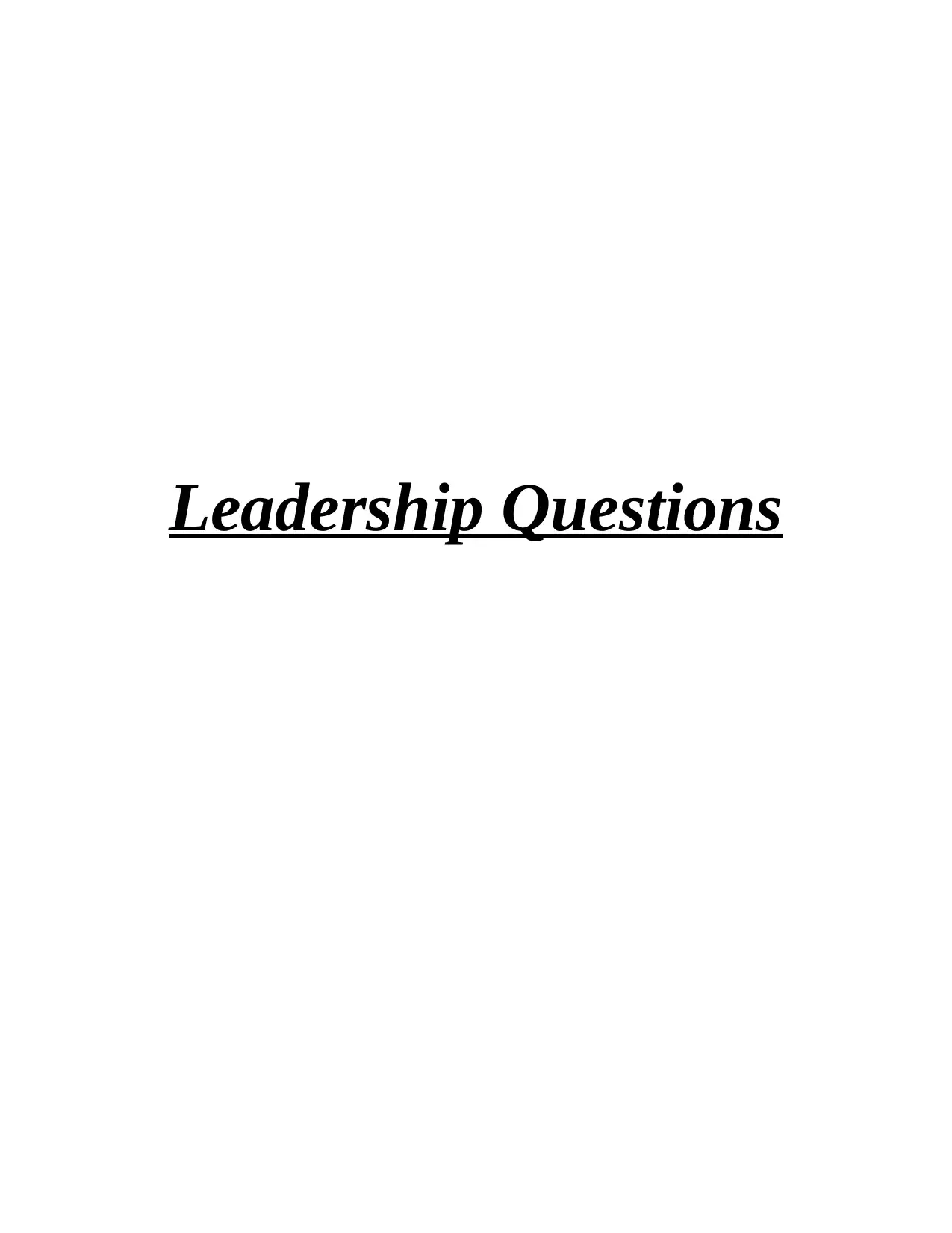
Leadership Questions
Paraphrase This Document
Need a fresh take? Get an instant paraphrase of this document with our AI Paraphraser
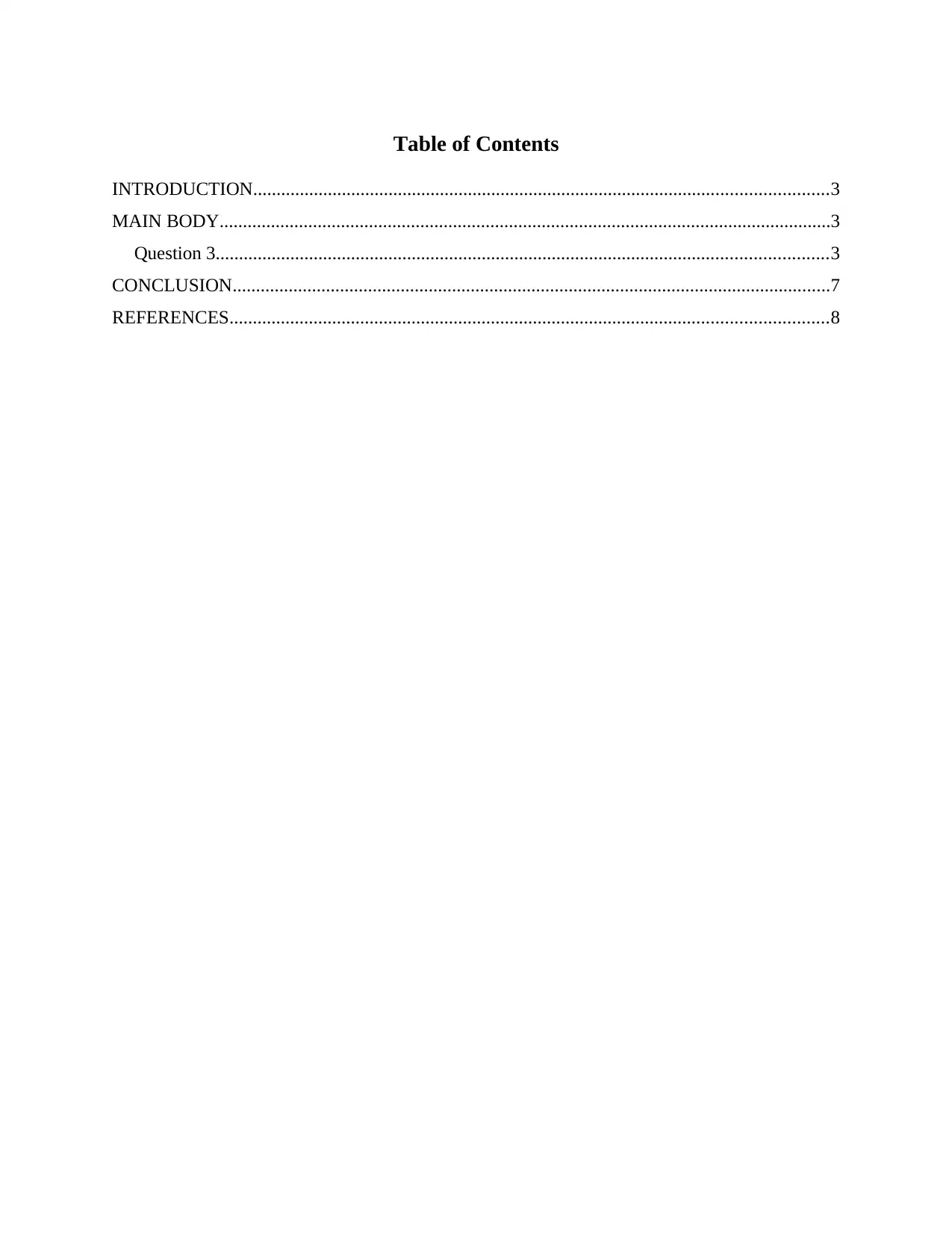
Table of Contents
INTRODUCTION...........................................................................................................................3
MAIN BODY...................................................................................................................................3
Question 3...................................................................................................................................3
CONCLUSION................................................................................................................................7
REFERENCES................................................................................................................................8
INTRODUCTION...........................................................................................................................3
MAIN BODY...................................................................................................................................3
Question 3...................................................................................................................................3
CONCLUSION................................................................................................................................7
REFERENCES................................................................................................................................8
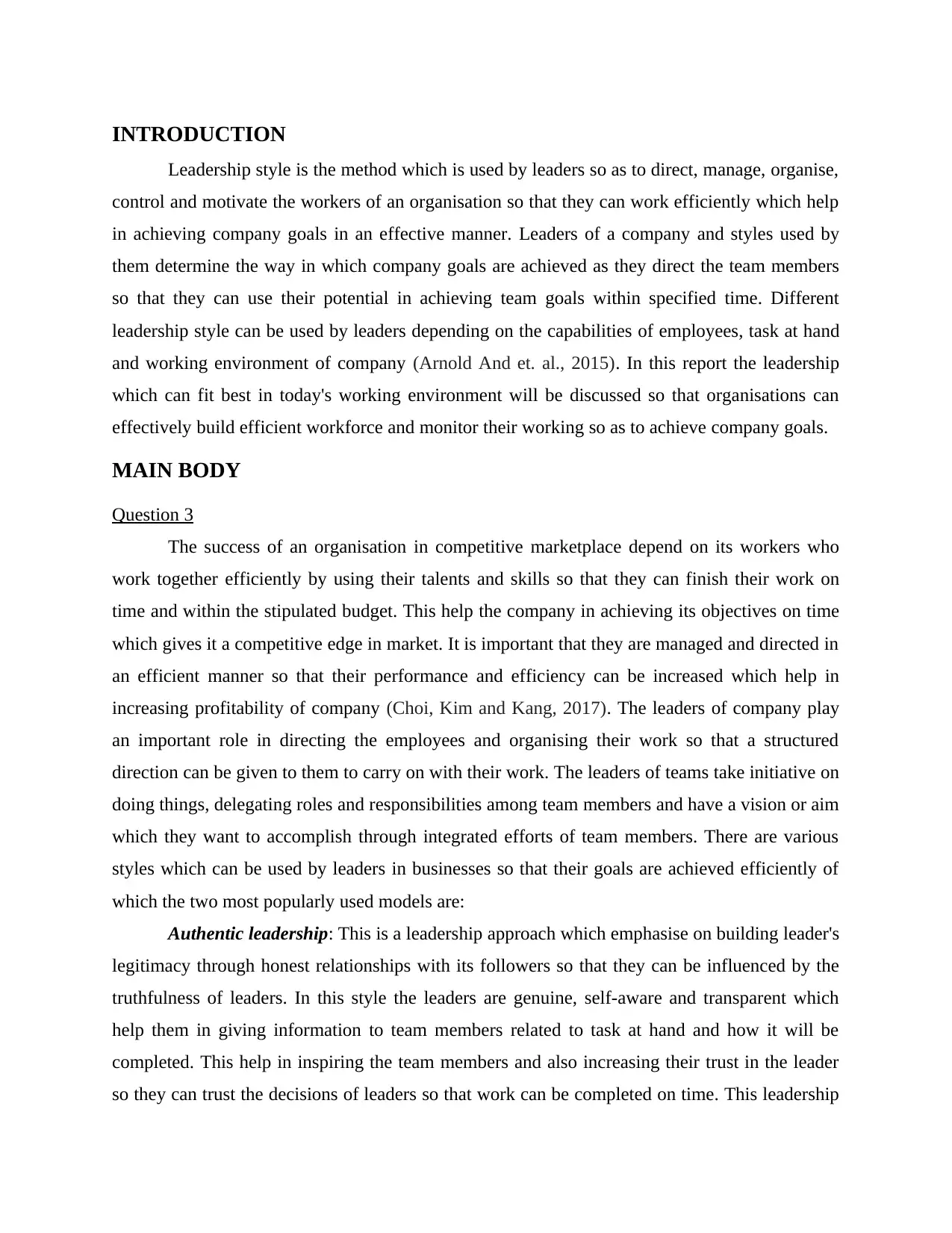
INTRODUCTION
Leadership style is the method which is used by leaders so as to direct, manage, organise,
control and motivate the workers of an organisation so that they can work efficiently which help
in achieving company goals in an effective manner. Leaders of a company and styles used by
them determine the way in which company goals are achieved as they direct the team members
so that they can use their potential in achieving team goals within specified time. Different
leadership style can be used by leaders depending on the capabilities of employees, task at hand
and working environment of company (Arnold And et. al., 2015). In this report the leadership
which can fit best in today's working environment will be discussed so that organisations can
effectively build efficient workforce and monitor their working so as to achieve company goals.
MAIN BODY
Question 3
The success of an organisation in competitive marketplace depend on its workers who
work together efficiently by using their talents and skills so that they can finish their work on
time and within the stipulated budget. This help the company in achieving its objectives on time
which gives it a competitive edge in market. It is important that they are managed and directed in
an efficient manner so that their performance and efficiency can be increased which help in
increasing profitability of company (Choi, Kim and Kang, 2017). The leaders of company play
an important role in directing the employees and organising their work so that a structured
direction can be given to them to carry on with their work. The leaders of teams take initiative on
doing things, delegating roles and responsibilities among team members and have a vision or aim
which they want to accomplish through integrated efforts of team members. There are various
styles which can be used by leaders in businesses so that their goals are achieved efficiently of
which the two most popularly used models are:
Authentic leadership: This is a leadership approach which emphasise on building leader's
legitimacy through honest relationships with its followers so that they can be influenced by the
truthfulness of leaders. In this style the leaders are genuine, self-aware and transparent which
help them in giving information to team members related to task at hand and how it will be
completed. This help in inspiring the team members and also increasing their trust in the leader
so they can trust the decisions of leaders so that work can be completed on time. This leadership
Leadership style is the method which is used by leaders so as to direct, manage, organise,
control and motivate the workers of an organisation so that they can work efficiently which help
in achieving company goals in an effective manner. Leaders of a company and styles used by
them determine the way in which company goals are achieved as they direct the team members
so that they can use their potential in achieving team goals within specified time. Different
leadership style can be used by leaders depending on the capabilities of employees, task at hand
and working environment of company (Arnold And et. al., 2015). In this report the leadership
which can fit best in today's working environment will be discussed so that organisations can
effectively build efficient workforce and monitor their working so as to achieve company goals.
MAIN BODY
Question 3
The success of an organisation in competitive marketplace depend on its workers who
work together efficiently by using their talents and skills so that they can finish their work on
time and within the stipulated budget. This help the company in achieving its objectives on time
which gives it a competitive edge in market. It is important that they are managed and directed in
an efficient manner so that their performance and efficiency can be increased which help in
increasing profitability of company (Choi, Kim and Kang, 2017). The leaders of company play
an important role in directing the employees and organising their work so that a structured
direction can be given to them to carry on with their work. The leaders of teams take initiative on
doing things, delegating roles and responsibilities among team members and have a vision or aim
which they want to accomplish through integrated efforts of team members. There are various
styles which can be used by leaders in businesses so that their goals are achieved efficiently of
which the two most popularly used models are:
Authentic leadership: This is a leadership approach which emphasise on building leader's
legitimacy through honest relationships with its followers so that they can be influenced by the
truthfulness of leaders. In this style the leaders are genuine, self-aware and transparent which
help them in giving information to team members related to task at hand and how it will be
completed. This help in inspiring the team members and also increasing their trust in the leader
so they can trust the decisions of leaders so that work can be completed on time. This leadership
⊘ This is a preview!⊘
Do you want full access?
Subscribe today to unlock all pages.

Trusted by 1+ million students worldwide
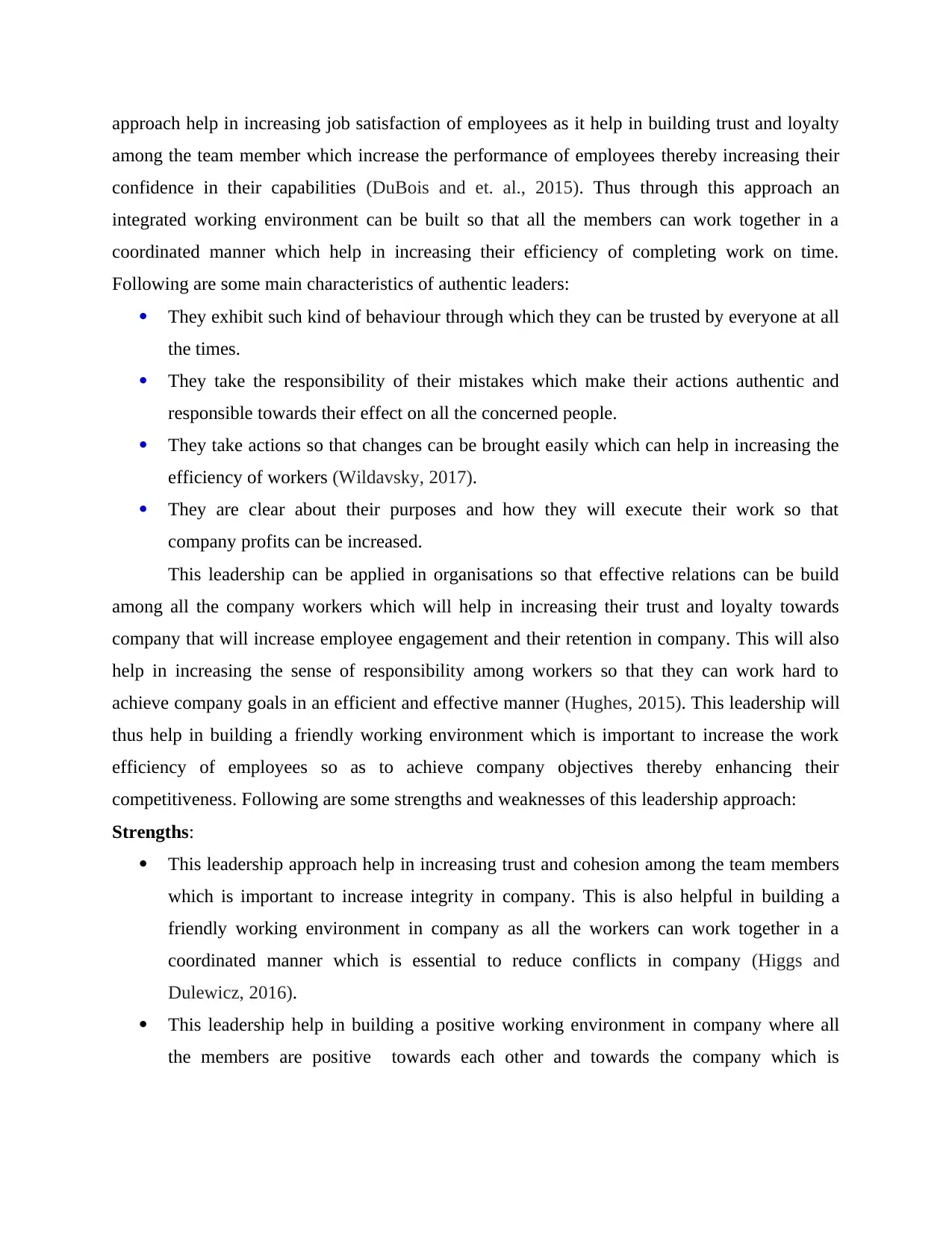
approach help in increasing job satisfaction of employees as it help in building trust and loyalty
among the team member which increase the performance of employees thereby increasing their
confidence in their capabilities (DuBois and et. al., 2015). Thus through this approach an
integrated working environment can be built so that all the members can work together in a
coordinated manner which help in increasing their efficiency of completing work on time.
Following are some main characteristics of authentic leaders:
They exhibit such kind of behaviour through which they can be trusted by everyone at all
the times.
They take the responsibility of their mistakes which make their actions authentic and
responsible towards their effect on all the concerned people.
They take actions so that changes can be brought easily which can help in increasing the
efficiency of workers (Wildavsky, 2017).
They are clear about their purposes and how they will execute their work so that
company profits can be increased.
This leadership can be applied in organisations so that effective relations can be build
among all the company workers which will help in increasing their trust and loyalty towards
company that will increase employee engagement and their retention in company. This will also
help in increasing the sense of responsibility among workers so that they can work hard to
achieve company goals in an efficient and effective manner (Hughes, 2015). This leadership will
thus help in building a friendly working environment which is important to increase the work
efficiency of employees so as to achieve company objectives thereby enhancing their
competitiveness. Following are some strengths and weaknesses of this leadership approach:
Strengths:
This leadership approach help in increasing trust and cohesion among the team members
which is important to increase integrity in company. This is also helpful in building a
friendly working environment in company as all the workers can work together in a
coordinated manner which is essential to reduce conflicts in company (Higgs and
Dulewicz, 2016).
This leadership help in building a positive working environment in company where all
the members are positive towards each other and towards the company which is
among the team member which increase the performance of employees thereby increasing their
confidence in their capabilities (DuBois and et. al., 2015). Thus through this approach an
integrated working environment can be built so that all the members can work together in a
coordinated manner which help in increasing their efficiency of completing work on time.
Following are some main characteristics of authentic leaders:
They exhibit such kind of behaviour through which they can be trusted by everyone at all
the times.
They take the responsibility of their mistakes which make their actions authentic and
responsible towards their effect on all the concerned people.
They take actions so that changes can be brought easily which can help in increasing the
efficiency of workers (Wildavsky, 2017).
They are clear about their purposes and how they will execute their work so that
company profits can be increased.
This leadership can be applied in organisations so that effective relations can be build
among all the company workers which will help in increasing their trust and loyalty towards
company that will increase employee engagement and their retention in company. This will also
help in increasing the sense of responsibility among workers so that they can work hard to
achieve company goals in an efficient and effective manner (Hughes, 2015). This leadership will
thus help in building a friendly working environment which is important to increase the work
efficiency of employees so as to achieve company objectives thereby enhancing their
competitiveness. Following are some strengths and weaknesses of this leadership approach:
Strengths:
This leadership approach help in increasing trust and cohesion among the team members
which is important to increase integrity in company. This is also helpful in building a
friendly working environment in company as all the workers can work together in a
coordinated manner which is essential to reduce conflicts in company (Higgs and
Dulewicz, 2016).
This leadership help in building a positive working environment in company where all
the members are positive towards each other and towards the company which is
Paraphrase This Document
Need a fresh take? Get an instant paraphrase of this document with our AI Paraphraser
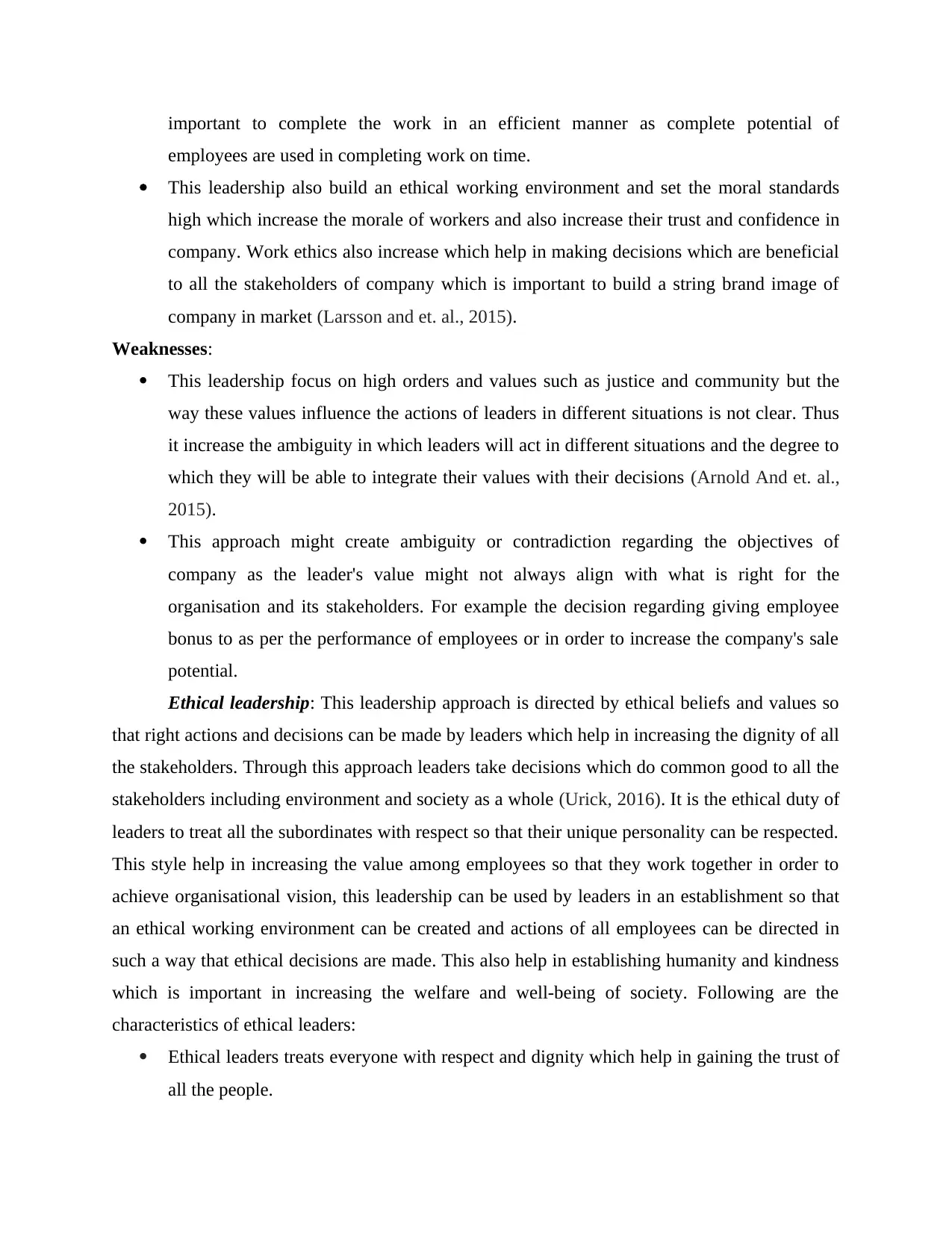
important to complete the work in an efficient manner as complete potential of
employees are used in completing work on time.
This leadership also build an ethical working environment and set the moral standards
high which increase the morale of workers and also increase their trust and confidence in
company. Work ethics also increase which help in making decisions which are beneficial
to all the stakeholders of company which is important to build a string brand image of
company in market (Larsson and et. al., 2015).
Weaknesses:
This leadership focus on high orders and values such as justice and community but the
way these values influence the actions of leaders in different situations is not clear. Thus
it increase the ambiguity in which leaders will act in different situations and the degree to
which they will be able to integrate their values with their decisions (Arnold And et. al.,
2015).
This approach might create ambiguity or contradiction regarding the objectives of
company as the leader's value might not always align with what is right for the
organisation and its stakeholders. For example the decision regarding giving employee
bonus to as per the performance of employees or in order to increase the company's sale
potential.
Ethical leadership: This leadership approach is directed by ethical beliefs and values so
that right actions and decisions can be made by leaders which help in increasing the dignity of all
the stakeholders. Through this approach leaders take decisions which do common good to all the
stakeholders including environment and society as a whole (Urick, 2016). It is the ethical duty of
leaders to treat all the subordinates with respect so that their unique personality can be respected.
This style help in increasing the value among employees so that they work together in order to
achieve organisational vision, this leadership can be used by leaders in an establishment so that
an ethical working environment can be created and actions of all employees can be directed in
such a way that ethical decisions are made. This also help in establishing humanity and kindness
which is important in increasing the welfare and well-being of society. Following are the
characteristics of ethical leaders:
Ethical leaders treats everyone with respect and dignity which help in gaining the trust of
all the people.
employees are used in completing work on time.
This leadership also build an ethical working environment and set the moral standards
high which increase the morale of workers and also increase their trust and confidence in
company. Work ethics also increase which help in making decisions which are beneficial
to all the stakeholders of company which is important to build a string brand image of
company in market (Larsson and et. al., 2015).
Weaknesses:
This leadership focus on high orders and values such as justice and community but the
way these values influence the actions of leaders in different situations is not clear. Thus
it increase the ambiguity in which leaders will act in different situations and the degree to
which they will be able to integrate their values with their decisions (Arnold And et. al.,
2015).
This approach might create ambiguity or contradiction regarding the objectives of
company as the leader's value might not always align with what is right for the
organisation and its stakeholders. For example the decision regarding giving employee
bonus to as per the performance of employees or in order to increase the company's sale
potential.
Ethical leadership: This leadership approach is directed by ethical beliefs and values so
that right actions and decisions can be made by leaders which help in increasing the dignity of all
the stakeholders. Through this approach leaders take decisions which do common good to all the
stakeholders including environment and society as a whole (Urick, 2016). It is the ethical duty of
leaders to treat all the subordinates with respect so that their unique personality can be respected.
This style help in increasing the value among employees so that they work together in order to
achieve organisational vision, this leadership can be used by leaders in an establishment so that
an ethical working environment can be created and actions of all employees can be directed in
such a way that ethical decisions are made. This also help in establishing humanity and kindness
which is important in increasing the welfare and well-being of society. Following are the
characteristics of ethical leaders:
Ethical leaders treats everyone with respect and dignity which help in gaining the trust of
all the people.

They place the interest of their subordinates ahead of their own which make their nature
as serving to others (Mathew and Gupta, 2015).
They are always fair and just in their actions and treats everyone fairly and equally.
They pay attention in building good and long-term relations with employees so that an
integrated work environment can be created and employee engagement can help in
increasing their motivation to work in an efficient manner.
This leadership can be applied in businesses so that the decisions that are made can help
in increasing the ethical image of company which will help it in gaining support from society,
community and government so that they can continue to achieve their long-term goals and
objectives (Walker and Aritz, 2015). This theory can also help in increasing the economic and
environmental development of their surrounding which will help in increasing their
responsibility towards the society. Thus the brand image of company can increase by using this
leadership approach. The approach has following advantages and disadvantages:
Strengths:
This approach help in following all the laws and legal guidelines so that a working
environment is created which help in increasing the welfare of all the employees.
This leadership also help in building a healthier workplace culture as everyone respect
each other which builds a positive working environment that builds strong relationships
among employees and increase the morale of employees.
This approach also increase accountability of all the workers which will increase their
responsibility towards all the stakeholders so that highest interest can be given (Huber,
2017).
Weaknesses:
It requires comprehensive support of all the employees so that ethical decisions can be
made which will result in increasing welfare of all the stakeholders.
This leadership approach must be consistently applied while taking any decisions so that
overall ethical decisions can be made which help in increasing the ethical actions taken
by company (Zareen, Razzaq and Mujtaba, 2015).
The success of this approach depend on the ability of leaders to influence the workers to
follow the values and beliefs of leaders.
The leadership style that can be adopted by an organisation:
as serving to others (Mathew and Gupta, 2015).
They are always fair and just in their actions and treats everyone fairly and equally.
They pay attention in building good and long-term relations with employees so that an
integrated work environment can be created and employee engagement can help in
increasing their motivation to work in an efficient manner.
This leadership can be applied in businesses so that the decisions that are made can help
in increasing the ethical image of company which will help it in gaining support from society,
community and government so that they can continue to achieve their long-term goals and
objectives (Walker and Aritz, 2015). This theory can also help in increasing the economic and
environmental development of their surrounding which will help in increasing their
responsibility towards the society. Thus the brand image of company can increase by using this
leadership approach. The approach has following advantages and disadvantages:
Strengths:
This approach help in following all the laws and legal guidelines so that a working
environment is created which help in increasing the welfare of all the employees.
This leadership also help in building a healthier workplace culture as everyone respect
each other which builds a positive working environment that builds strong relationships
among employees and increase the morale of employees.
This approach also increase accountability of all the workers which will increase their
responsibility towards all the stakeholders so that highest interest can be given (Huber,
2017).
Weaknesses:
It requires comprehensive support of all the employees so that ethical decisions can be
made which will result in increasing welfare of all the stakeholders.
This leadership approach must be consistently applied while taking any decisions so that
overall ethical decisions can be made which help in increasing the ethical actions taken
by company (Zareen, Razzaq and Mujtaba, 2015).
The success of this approach depend on the ability of leaders to influence the workers to
follow the values and beliefs of leaders.
The leadership style that can be adopted by an organisation:
⊘ This is a preview!⊘
Do you want full access?
Subscribe today to unlock all pages.

Trusted by 1+ million students worldwide
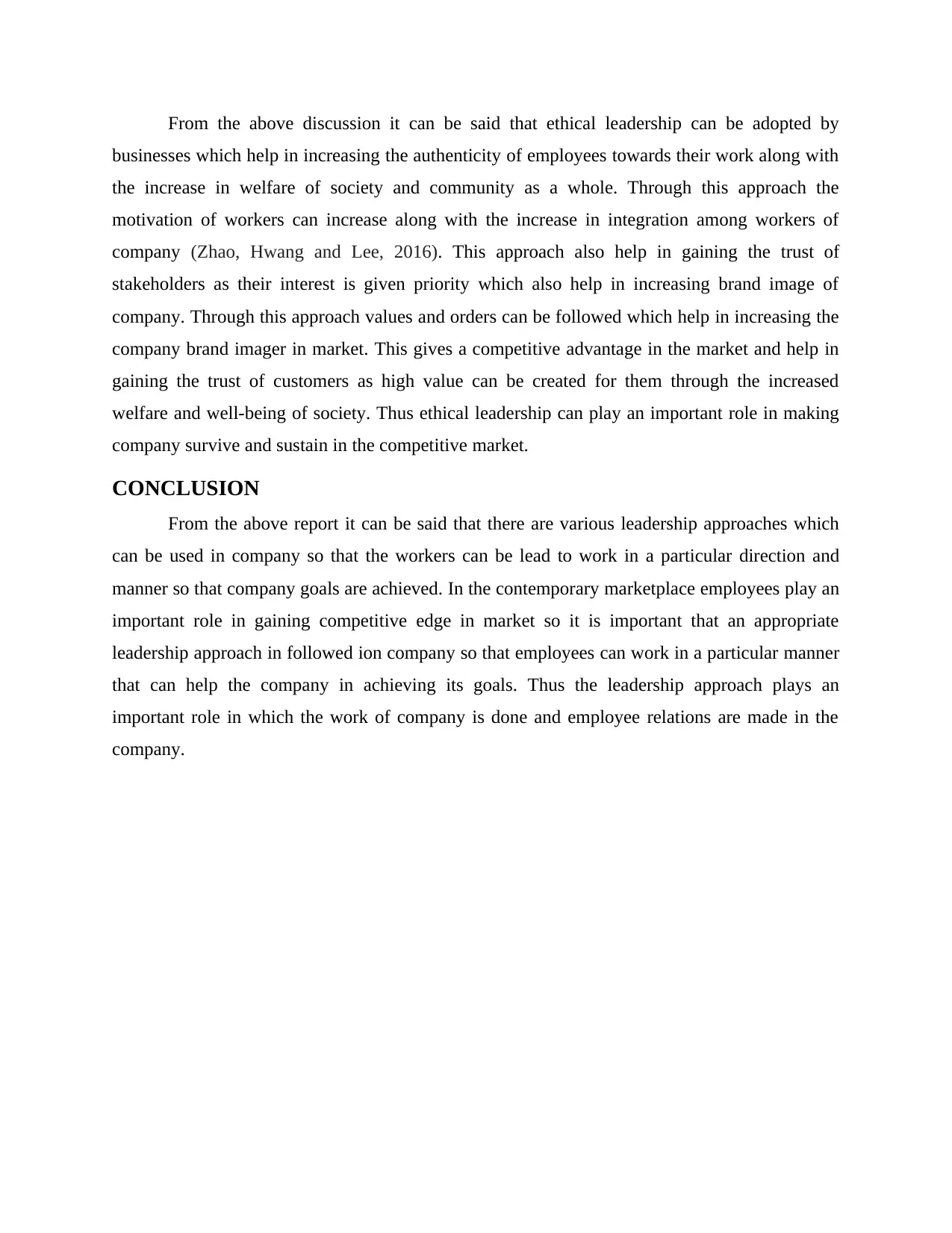
From the above discussion it can be said that ethical leadership can be adopted by
businesses which help in increasing the authenticity of employees towards their work along with
the increase in welfare of society and community as a whole. Through this approach the
motivation of workers can increase along with the increase in integration among workers of
company (Zhao, Hwang and Lee, 2016). This approach also help in gaining the trust of
stakeholders as their interest is given priority which also help in increasing brand image of
company. Through this approach values and orders can be followed which help in increasing the
company brand imager in market. This gives a competitive advantage in the market and help in
gaining the trust of customers as high value can be created for them through the increased
welfare and well-being of society. Thus ethical leadership can play an important role in making
company survive and sustain in the competitive market.
CONCLUSION
From the above report it can be said that there are various leadership approaches which
can be used in company so that the workers can be lead to work in a particular direction and
manner so that company goals are achieved. In the contemporary marketplace employees play an
important role in gaining competitive edge in market so it is important that an appropriate
leadership approach in followed ion company so that employees can work in a particular manner
that can help the company in achieving its goals. Thus the leadership approach plays an
important role in which the work of company is done and employee relations are made in the
company.
businesses which help in increasing the authenticity of employees towards their work along with
the increase in welfare of society and community as a whole. Through this approach the
motivation of workers can increase along with the increase in integration among workers of
company (Zhao, Hwang and Lee, 2016). This approach also help in gaining the trust of
stakeholders as their interest is given priority which also help in increasing brand image of
company. Through this approach values and orders can be followed which help in increasing the
company brand imager in market. This gives a competitive advantage in the market and help in
gaining the trust of customers as high value can be created for them through the increased
welfare and well-being of society. Thus ethical leadership can play an important role in making
company survive and sustain in the competitive market.
CONCLUSION
From the above report it can be said that there are various leadership approaches which
can be used in company so that the workers can be lead to work in a particular direction and
manner so that company goals are achieved. In the contemporary marketplace employees play an
important role in gaining competitive edge in market so it is important that an appropriate
leadership approach in followed ion company so that employees can work in a particular manner
that can help the company in achieving its goals. Thus the leadership approach plays an
important role in which the work of company is done and employee relations are made in the
company.
Paraphrase This Document
Need a fresh take? Get an instant paraphrase of this document with our AI Paraphraser
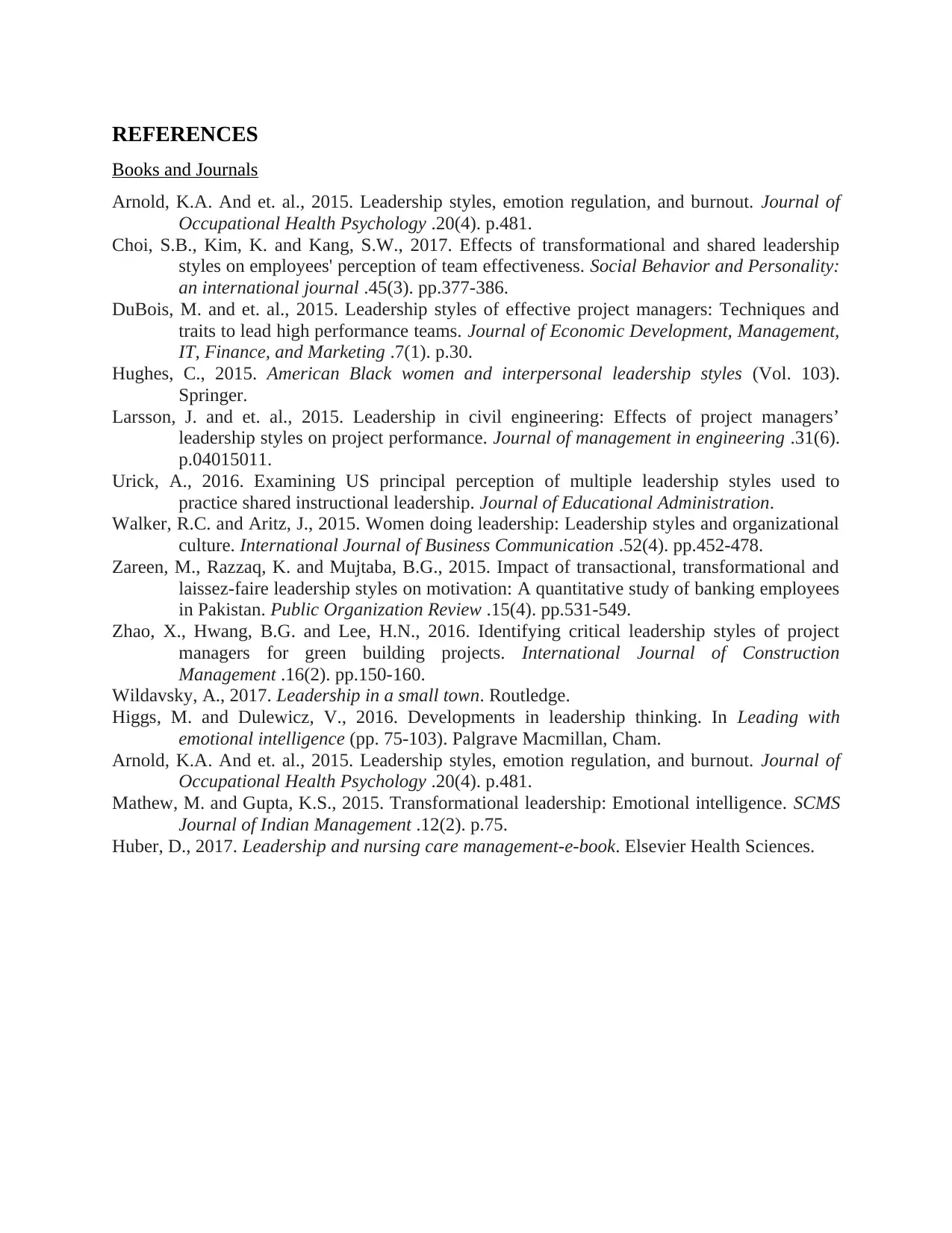
REFERENCES
Books and Journals
Arnold, K.A. And et. al., 2015. Leadership styles, emotion regulation, and burnout. Journal of
Occupational Health Psychology .20(4). p.481.
Choi, S.B., Kim, K. and Kang, S.W., 2017. Effects of transformational and shared leadership
styles on employees' perception of team effectiveness. Social Behavior and Personality:
an international journal .45(3). pp.377-386.
DuBois, M. and et. al., 2015. Leadership styles of effective project managers: Techniques and
traits to lead high performance teams. Journal of Economic Development, Management,
IT, Finance, and Marketing .7(1). p.30.
Hughes, C., 2015. American Black women and interpersonal leadership styles (Vol. 103).
Springer.
Larsson, J. and et. al., 2015. Leadership in civil engineering: Effects of project managers’
leadership styles on project performance. Journal of management in engineering .31(6).
p.04015011.
Urick, A., 2016. Examining US principal perception of multiple leadership styles used to
practice shared instructional leadership. Journal of Educational Administration.
Walker, R.C. and Aritz, J., 2015. Women doing leadership: Leadership styles and organizational
culture. International Journal of Business Communication .52(4). pp.452-478.
Zareen, M., Razzaq, K. and Mujtaba, B.G., 2015. Impact of transactional, transformational and
laissez-faire leadership styles on motivation: A quantitative study of banking employees
in Pakistan. Public Organization Review .15(4). pp.531-549.
Zhao, X., Hwang, B.G. and Lee, H.N., 2016. Identifying critical leadership styles of project
managers for green building projects. International Journal of Construction
Management .16(2). pp.150-160.
Wildavsky, A., 2017. Leadership in a small town. Routledge.
Higgs, M. and Dulewicz, V., 2016. Developments in leadership thinking. In Leading with
emotional intelligence (pp. 75-103). Palgrave Macmillan, Cham.
Arnold, K.A. And et. al., 2015. Leadership styles, emotion regulation, and burnout. Journal of
Occupational Health Psychology .20(4). p.481.
Mathew, M. and Gupta, K.S., 2015. Transformational leadership: Emotional intelligence. SCMS
Journal of Indian Management .12(2). p.75.
Huber, D., 2017. Leadership and nursing care management-e-book. Elsevier Health Sciences.
Books and Journals
Arnold, K.A. And et. al., 2015. Leadership styles, emotion regulation, and burnout. Journal of
Occupational Health Psychology .20(4). p.481.
Choi, S.B., Kim, K. and Kang, S.W., 2017. Effects of transformational and shared leadership
styles on employees' perception of team effectiveness. Social Behavior and Personality:
an international journal .45(3). pp.377-386.
DuBois, M. and et. al., 2015. Leadership styles of effective project managers: Techniques and
traits to lead high performance teams. Journal of Economic Development, Management,
IT, Finance, and Marketing .7(1). p.30.
Hughes, C., 2015. American Black women and interpersonal leadership styles (Vol. 103).
Springer.
Larsson, J. and et. al., 2015. Leadership in civil engineering: Effects of project managers’
leadership styles on project performance. Journal of management in engineering .31(6).
p.04015011.
Urick, A., 2016. Examining US principal perception of multiple leadership styles used to
practice shared instructional leadership. Journal of Educational Administration.
Walker, R.C. and Aritz, J., 2015. Women doing leadership: Leadership styles and organizational
culture. International Journal of Business Communication .52(4). pp.452-478.
Zareen, M., Razzaq, K. and Mujtaba, B.G., 2015. Impact of transactional, transformational and
laissez-faire leadership styles on motivation: A quantitative study of banking employees
in Pakistan. Public Organization Review .15(4). pp.531-549.
Zhao, X., Hwang, B.G. and Lee, H.N., 2016. Identifying critical leadership styles of project
managers for green building projects. International Journal of Construction
Management .16(2). pp.150-160.
Wildavsky, A., 2017. Leadership in a small town. Routledge.
Higgs, M. and Dulewicz, V., 2016. Developments in leadership thinking. In Leading with
emotional intelligence (pp. 75-103). Palgrave Macmillan, Cham.
Arnold, K.A. And et. al., 2015. Leadership styles, emotion regulation, and burnout. Journal of
Occupational Health Psychology .20(4). p.481.
Mathew, M. and Gupta, K.S., 2015. Transformational leadership: Emotional intelligence. SCMS
Journal of Indian Management .12(2). p.75.
Huber, D., 2017. Leadership and nursing care management-e-book. Elsevier Health Sciences.
1 out of 8
Related Documents
Your All-in-One AI-Powered Toolkit for Academic Success.
+13062052269
info@desklib.com
Available 24*7 on WhatsApp / Email
![[object Object]](/_next/static/media/star-bottom.7253800d.svg)
Unlock your academic potential
Copyright © 2020–2025 A2Z Services. All Rights Reserved. Developed and managed by ZUCOL.




